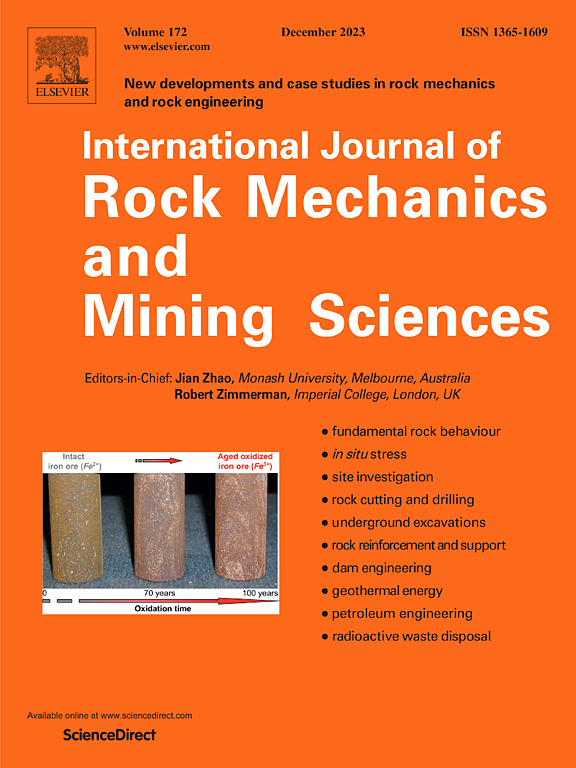What if chalk becomes mechanically weaker during supercritical CO2 injection in a depleted gas reservoir?
IF 7
1区 工程技术
Q1 ENGINEERING, GEOLOGICAL
International Journal of Rock Mechanics and Mining Sciences
Pub Date : 2025-03-29
DOI:10.1016/j.ijrmms.2025.106093
引用次数: 0
Abstract
Even though most past endeavors concluded no significant mechanical weakening of chalk flooded by supercritical CO2, here, we comprehensively assess the mechanical response of a depleted chalk reservoir by considering the most pessimistic experimental results reported in literature in terms of mechanical alteration of chalk by supercritical CO2. The primary aim stems from the lack of simulation studies documenting the deformation behaviour of CO2 storage site in chalk. We perform a series of hydro-mechanical simulations on the Harald East gas field, the first candidate worldwide to store CO2 in chalk formations located in the Danish North Sea. Different scenarios are considered by modifying the injection schemes (intermittent vs. continuous, low vs. high injection rate) and assumptions regarding the CO2-induced alteration of the rock's properties. The subsidence trends of the reservoir top and the distribution of stress and elasto-visco-plastic strain across the reservoir, underburden, and along the wells are compared between scenarios. Besides, the mechanical responses of subsurface chalk upon pressure depletion during gas production and repressurisation by CO2 injection are reviewed. The results highlight the effects of stress arching occurring during production as well as the injection rate, distance of porous chalk from injectors, timing between repressurisation and CO2 propagation, and elastic strain rebound on the deformation response of the storage site. The present study also indicates that the field exhibits an overall negligible to minor deformation during the injection phase compared to the production phase, thereby providing encouraging results on the feasibility of re-purposing depleted chalk reservoirs as storage sites.
如果在枯竭气藏中超临界CO2注入过程中,白垩粉的机械强度变弱,该怎么办?
尽管过去的大多数研究都没有得出超临界CO2对白垩的机械弱化作用的显著结论,但在这里,我们综合考虑了文献中关于超临界CO2对白垩的力学改变的最悲观的实验结果,对枯竭白垩储层的力学响应进行了全面评估。主要目的源于缺乏记录白垩中二氧化碳储存部位变形行为的模拟研究。我们对Harald East气田进行了一系列流体力学模拟,该气田位于丹麦北海,是世界上第一个将二氧化碳储存在白垩地层中的候选气田。通过修改注入方案(间歇注入与连续注入、低注入速率与高注入速率)以及关于二氧化碳引起岩石性质改变的假设,可以考虑不同的情况。对比了不同情景下储层顶部的沉降趋势以及应力和弹粘塑性应变在储层、下覆层和井上的分布。此外,还回顾了地下白垩在采气过程中压力枯竭和CO2注入增压时的力学响应。研究结果强调了生产过程中发生的应力拱起、注入速度、多孔白垩与注入器的距离、再增压与CO2传播之间的时间以及弹性应变回弹对储层变形响应的影响。目前的研究还表明,与生产阶段相比,该油田在注入阶段的整体变形可以忽略不计,从而为重新利用枯竭的白垩油藏作为储存地点的可行性提供了令人鼓舞的结果。
本文章由计算机程序翻译,如有差异,请以英文原文为准。
求助全文
约1分钟内获得全文
求助全文
来源期刊
CiteScore
14.00
自引率
5.60%
发文量
196
审稿时长
18 weeks
期刊介绍:
The International Journal of Rock Mechanics and Mining Sciences focuses on original research, new developments, site measurements, and case studies within the fields of rock mechanics and rock engineering. Serving as an international platform, it showcases high-quality papers addressing rock mechanics and the application of its principles and techniques in mining and civil engineering projects situated on or within rock masses. These projects encompass a wide range, including slopes, open-pit mines, quarries, shafts, tunnels, caverns, underground mines, metro systems, dams, hydro-electric stations, geothermal energy, petroleum engineering, and radioactive waste disposal. The journal welcomes submissions on various topics, with particular interest in theoretical advancements, analytical and numerical methods, rock testing, site investigation, and case studies.

 求助内容:
求助内容: 应助结果提醒方式:
应助结果提醒方式:


